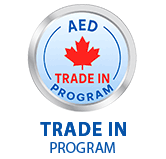Sudden Cardiac Arrest
What Is Sudden Cardiac Arrest (SCA)?
SCA occurs when the heart suddenly stops beating effectively due to an electrical malfunction. The person collapses, becomes unresponsive, stops breathing, and has no pulse. Without rapid intervention, SCA is almost fatal.
Good news: An AED can restore normal rhythm with a life-saving electric shock. The combination of AED and CPR can increase the survival rate of SCA victims by 40%.
Is SCA The Same As A Heart Attack?
No, they’re different. A heart attack is caused by a blockage in the arteries a "plumbing" problem, while SCA is an “electrical” malfunction of the heart. A heart attack can lead to SCA, but they are distinct conditions.
Who Is At Risk Of SCA?
Sudden Cardiac Arrest can strike anyone, at any time. Children, Athletes, Teenagers, and Healthy Adults can all suffer from SCA—even those without any prior risk factors. That’s why having an AED Advantage helps you respond confidently and effectively. AEDs should be accessible in public and private settings.
What Is The Recommended Treatment For SCA?
Defibrillation is the only proven method to restore normal heart rhythm in the event of SCA.
What Does The Heart & Stroke Foundation Say About AEDs?
The Heart & Stroke Foundation advocates for the widespread availability of AEDs in homes, workplaces, and public spaces. They recommend that anyone in regular contact with high-risk individuals—such as family members, police, and security staff—receive AED training.
What Is Ventricular Fibrillation (VF)?
VF is the most common abnormal heart rhythm that is found in victims of Sudden Cardiac Arrest (SCA). It occurs when the electrical system malfunctions, which causes the lower chambers (Ventricles) to quiver instead of in a coordinated rhythm.
Due to that, the heart cannot pump blood effectively into the brain and other important organs. Without immediate treatment, VF rapidly deteriorates into asystole (Flatline) making survival impossible without early intervention very critical.
Learn more about VF
How Is Ventricular Fibrillation (VF) Treated?
The only effective treatment for VF is defibrillation which proves a controlled electric shock to the heart which gives the heart a chance to reset and restore in a normal rhythm. An AED is designed to provide VF victims with defibrillation.
AEDs Are Designed To:
- Detect life-threatening rhythms automatically
- Guide rescuers with clear voice and visual prompts
- Deliver a shock safety













